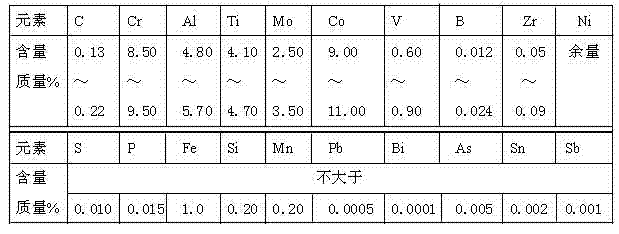Method for preparing K417G alloy by using DZ417G alloy return material
A technology for returning materials and alloys, which is applied in the field of preparing K417G alloy to achieve the effects of good stability, cost saving and waste reduction
- Summary
- Abstract
- Description
- Claims
- Application Information
AI Technical Summary
Problems solved by technology
Method used
Image
Examples
Embodiment 1
[0033] The process of preparing K417G alloy by using DZ417G alloy return material is as follows.
[0034] (1) DZ417G alloy return material pretreatment
[0035] Sand blasting is carried out on the returned materials generated during the production of DZ417G castings.
[0036] The return material is the pouring system and the waste castings contain ceramic cores and ceramic filter screens. First, the core is removed. The core is removed by a high-pressure core removal kettle, and caustic potash is used to remove the core. According to the mass ratio, caustic potash: water = 7 : 5; the core removal pressure is 0.4MPa, the lye temperature is 170°C, and the core removal time is 13 minutes. After the core removal is completed, put the returned material into hydrochloric acid with a mass concentration of 4% for neutralization. The neutralization time is 13 minutes, and the neutralization is completed. Then perform sand blasting.
[0037] Put the returned material into the sand blo...
Embodiment 2
[0050] The process of preparing K417G alloy by using DZ417G alloy return material is as follows.
[0051] (1) DZ417G alloy return material pretreatment
[0052] Sand blasting is carried out on the returned materials generated during the production of DZ417G castings.
[0053] The return material is the pouring system and the waste castings contain ceramic cores and ceramic filter screens, which need to be removed first. The high-pressure core removal kettle is used for the removal of the core, and the caustic potash is used for the removal of the core. According to the mass ratio, caustic potash: water = 7:3; the core removal pressure is 0.5MPa, the lye temperature is 210°C, and the core removal time is 10 minutes. After the core removal is completed, put the returned material into hydrochloric acid with a mass concentration of 5% for neutralization. Sand blasting is performed after completion. Put the returned material into the sand blowing machine, control the compressed a...
Embodiment 3
[0066] The process of preparing K417G alloy by using DZ417G alloy return material is as follows.
[0067] (1) DZ417G alloy return material pretreatment
[0068] The return material is the pouring system and the waste castings contain ceramic cores and ceramic filter screens, which need to be removed first. The high-pressure core removal kettle is used for the removal of the core, and the caustic potash is used for the removal of the core. According to the mass ratio, caustic potash: water = 1:1; the core removal pressure is 0.3MPa, the lye temperature is 130°C, and the core removal time is 15 minutes. After the core removal is completed, put the returned material into hydrochloric acid with a mass concentration of 3% for neutralization. Sand blasting is performed after completion. Put the returned material into the sand blowing machine, the compressed air pressure is controlled at 0.2MPa, and the corundum sand with a particle size of 1mm is used for sand blasting to blow the ...
PUM
| Property | Measurement | Unit |
|---|---|---|
| particle size | aaaaa | aaaaa |
Abstract
Description
Claims
Application Information
 Login to View More
Login to View More - R&D
- Intellectual Property
- Life Sciences
- Materials
- Tech Scout
- Unparalleled Data Quality
- Higher Quality Content
- 60% Fewer Hallucinations
Browse by: Latest US Patents, China's latest patents, Technical Efficacy Thesaurus, Application Domain, Technology Topic, Popular Technical Reports.
© 2025 PatSnap. All rights reserved.Legal|Privacy policy|Modern Slavery Act Transparency Statement|Sitemap|About US| Contact US: help@patsnap.com



